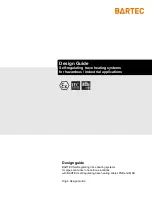
DCA
Page 3
Table 2 lists the performance and operational specifi-
cations for the unit.
Options
Each DCA is configured according to customer
requirements. The paragraphs on the following pages
highlight some of the options available.
Table 2.
DCA Performance and Operational Specifications
Characteristic
Input
Output
Power
Performance
Environmental
Ratings
Specifications
Current:
1-5 mA @ 200
Ω
nominal input impedance
4-20 mA @ 50
Ω
nominal input impedance
10-50 mA @ 20
Ω
nominal input impedance
Selectable Current (SC) comes with three load resistors for selecting1-5, 4-20, or
10-50 mA (See Note 1)
Voltage:
0.25-1.25 V @ 1M
Ω
, minimum (See Note 2)
1-5 V @ 1M
Ω
, minimum
Consult factory for dual input and special range options.
Factory-configured with one (Single DCA) or two (Dual DCA) single pole/double throw
(SPDT), form C, mechanical relays rated for 5 A @ 117 Vac non-inductive, or 28 Vdc.
User selects Normally Open (NO), Normally Closed (NC), or any combination of NO/NC
configurations during installation. Fail-safe/Non-fail-safe configuration factory-set. Refer to
table 1 for available combinations.
Double pole/double throw (DPDT), form 2C and 7.5 A relays available as options.
(See Note 3)
24 or 45 Vdc ±10%, 5 watts nominal
100, 117, 200, 220, or 240 Vac ±10%, 50/60 Hz
AC power inputs not available with PC-style housing
Repeatability:
Trip point settings repeat within ±0.1% of span.
Dead Band:
1% of span, standard. Adjustable Dead Band Option available.
Alarm Response:
50 milliseconds for step change of 1% of span.
Line Voltage Effect:
±0.005% per 1% line voltage change (ac or dc).
Isolation:
No galvanic path between input, output, and power.
Accuracy:
Front panel potentiometers capable of setting trip points from 0 to 100% of
span. Lockable, scaled vernier dials optional.
Effect of Ambient Temperature on Performance:
Less than ±0.018% per °C through the
specified range (Less than ±0.01% per °F)
Ambient Operating Temperature:
–18 to 65 °C (0 to 150 °F)
NOTES:
1. One of the available resistors MUST be installed.
2. Requires extra engineering when used with some option combinations.
3. DPDT not available with some enclosures and option combinations.






































